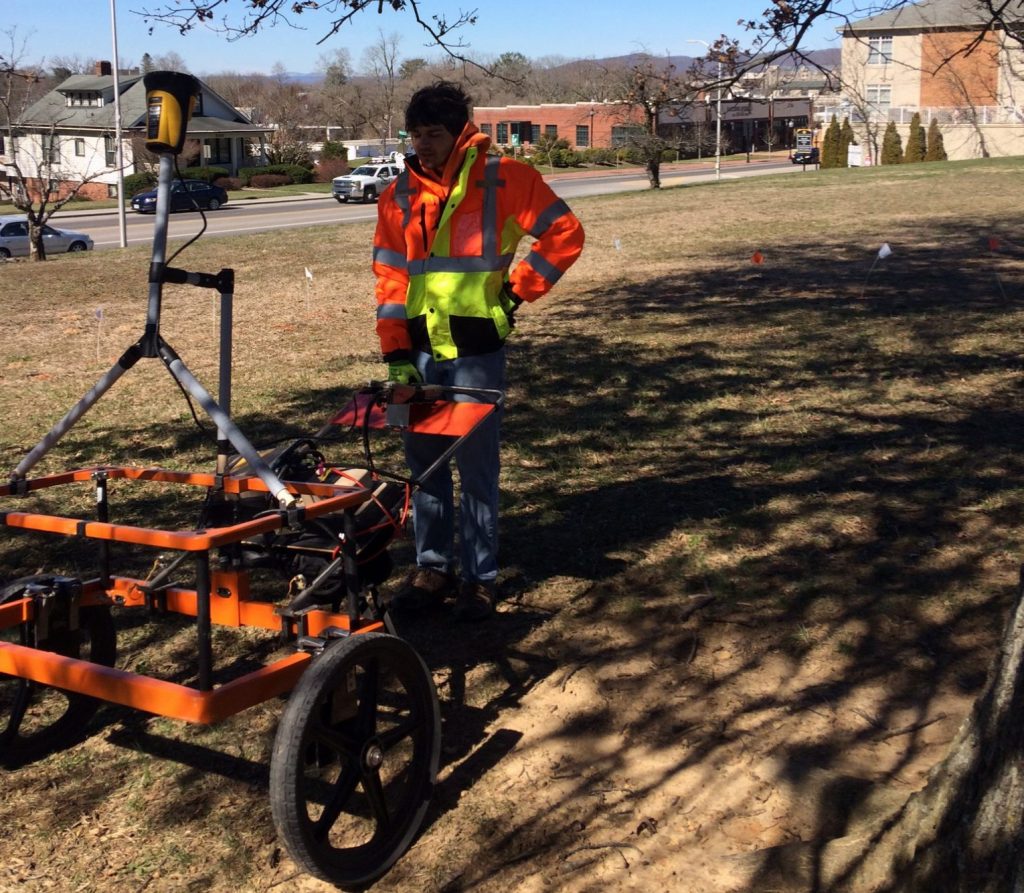
In sun and the spanking gale whipping across the grass and gravel of the Old Blackburg Middle School site, a small cluster of people, some in orange and yellow vests, gathered beside a handsome oak tree to connect Blacksburg’s past to its present and maybe its future.
The group was there to search for a time capsule thought to have been buried at the foot of the oak in 1976 by Blacksburg middle schoolers as they and the nation celebrated America’s 200th birthday.
Several of those former middle-schoolers were standing in the wind to cheer on local engineering firm Draper Aden Associates, Radford University geology students, and some very futuristic engineering equipment that would be scanning the ground, collecting and analyzing the data to see what there might be hidden beneath the old field.
“We thought this would be a good public service,” Ted Dean, Geophysical Services team leader with Draper Aden said. “This is the kind of thing my team does on a regular basis, and we thought it would just be a nice thing to do for the community.”
Spurred by the imminent development of the OBMS site, the leveling of its trees and the churning up and binning of whatever might be in its soil, the history of the oak and a possible time capsule were brought to light by Paul McMahan, who was among those eighth graders, teachers and dignitaries who gathered on very nearly the same spot on a hot, early summer day 42 years ago.
Now, McMahan has launched a social media campaign asking schoolmates what they remember about the celebration, the tree planting and the contents of the time capsule.
While everyone recalls a warm, small-town pride, their shared memory is capricious: someone remembers the time capsule being buried under the tree, someone else recalls it buried on the small knoll at the corner of the school, while others recall it being lost, while still others are sure there was never a time capsule at all.
“We were just kids. We weren’t thinking about digging it back up,” McMahan said laughing. “We don’t know if it was metal. We do know the tree was planted in the very front of the school and you can still see how the sidewalk arched around it.”
As mid-morning traffic rolled by on Main Street, the engineers unloaded ground penetrating radar and electromagnetic induction equipment.
With this equipment Draper Aden usually looks for utilities or abandoned underground storage tanks, and old, forgotten foundations.
“Hopefully, if the container is made of metal or if there is a substantial metal object in it we’ll see it with that,” Dean said.
The electromagnetic induction sensor is essentially a sophisticated metal detector made like a big orange lawnmower.
The pushable metal detector on knobby wheels that emits a steady hum driving back and forth sending electromagnetic waves down through the soil.
The strategy pairs the metal detector with ground penetrating radar that isn’t specific to metal. Ground penetrating radar will find buried objects or even places where the soil has been disturbed.
“It shows reflections off buried objects, and the electromagnetic induction maps as you move along tracking your movements by GPS. If there’s something more conductive as you move along you can actually hear it like a metal detector it’ll start whistling really high,” Chris Printz, senior project geologist at Draper Ade, said, spray-painting orange lines and arrows in the grass, laying out a 60’ x 60’ grid.
The problem is that it won’t be able to distinguish between a buried paint can and a time capsule. A groundhog hole or a soda can.”
Draper Aden will evaluate the data using analytical software and know within a week or so what the equipment has recorded and where.
Using this equipment to uncover the world beneath our feet, Draper Aden has done jobs in almost every state east of the Mississippi on projects as wildly different as abandoned coal-mine investigations, bedrock mapping, and the identification of graves in the centuries-old Hollywood Cemetery in Richmond.
“We had multiple jobs to squeeze in that day,” Printz said, “and we got to the cemetery site at about 6:30 at night. We marked out the grid just as the sun was setting, the full moon was up and the owls were hooting in the trees about 50 feet away while we’re clearly seeing two-hundred year old buried-body images, or the soil disturbed by where the bodies had long ago been, on the glowing screens. Pretty cool,” he said.
There was laughter and talking as the group watched Ethan Truman, staff geologist, mow up and down in the sunny grass, ducking under the branches and brown leaves.
Suddenly, Truman stopped and trotted over to Printz.
“We think we got a hit,” Truman said.
Ducking under the branches, everyone came over to hear. Truman backed up the contraption and drove over a spot again. The detector’s hum rises to a whistle.
Over the afternoon, the team finds another promising spot over on the grassy knoll. They tests and double-check them with both instruments, driving in an ‘X’ to make sure they’re not long pipes or cables.
They’ve marked the spots with flags beneath the old oak and on the grassy knoll and will analyze the findings in the days to come to contribute to the history of Blacksburg.
To keep up on the time capsule and the fate of the tree itself visit the Facebook page “Old Blacksburg Middle School Historic Oak Tree and Time Capsule.”


